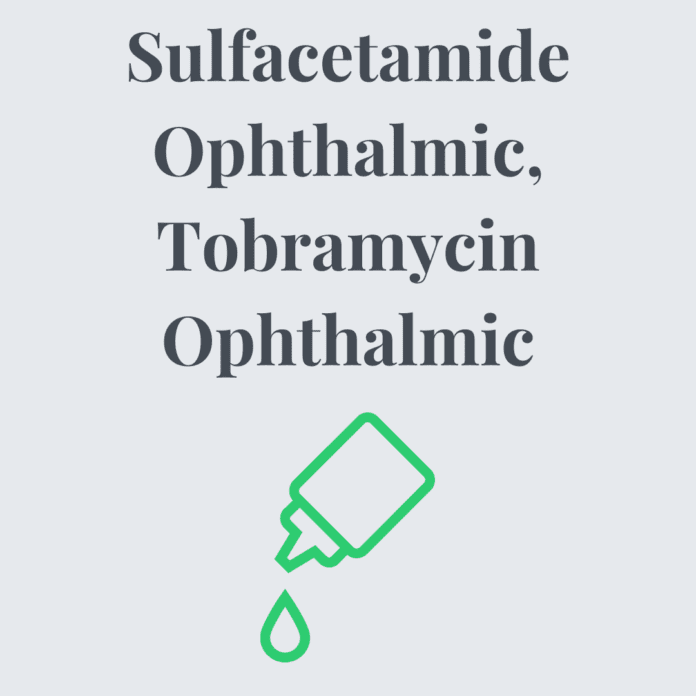Uses
Ophthalmic sulfacetamide stops the growth of bacteria that cause certain eye infections. It is used to treat eye infections and to prevent them after injuries.
Side Effects of Sulfacetamide Ophthalmic, Tobramycin Ophthalmic
Sulfacetamide ophthalmic may cause side effects. Tell your doctor if any of these symptoms are severe or do not go away:
- temporary stinging or burning of the eye
- increased redness, itching, or swelling of the eye that continues for more than 48 hours
Warnings & Precautions
Before using sulfacetamide ophthalmic:
- tell your doctor and pharmacist if you are allergic to sulfacetamide, sulfa drugs, sulfites, or any other drugs.
- tell your doctor and pharmacist what prescription and nonprescription medications you are taking, especially other eye medications and vitamins.
- tell your doctor if you are pregnant, plan to become pregnant, or are breast-feeding. If you become pregnant while using sulfacetamide ophthalmic, call your doctor immediately.
- you should know that your vision may be blurred during your treatment with sulfacetamide eye ointment. Avoid rubbing your eyes even if your vision is blurred. Do not drive a car or operate machinery if you are unable to see clearly.
- tell your doctor if you wear soft contact lenses. If the brand of sulfacetamide ophthalmic you are using contains benzalkonium chloride, wait at least 15 minutes after using the medicine to put in soft contact lenses.
Dosage of Sulfacetamide Ophthalmic, Tobramycin Ophthalmic
Ophthalmic sulfacetamide comes as a solution (liquid) to instill in the eyes, and an ointment to apply to the eyes. The eye drops usually are instilled every 2 to 3 hours during the day and less frequently at night; the ointment usually is applied four times a day and at bedtime. Follow the directions on your prescription label carefully, and ask your doctor or pharmacist to explain any part you do not understand. Use sulfacetamide ophthalmic exactly as directed. Do not use more or less of it or use it more often than prescribed by your doctor.
To instill sulfacetamide ophthalmic eye drops, follow these steps:
- Wash your hands thoroughly with soap and water.
- Check the dropper tip to make sure that it is not chipped or cracked.
- Avoid touching the dropper tip against your eye or anything else; eye drops and droppers must be kept clean.
- While tilting your head back, pull down the lower lid of your eye with your index finger to form a pocket.
- Hold the dropper (tip down) with the other hand, as close to the eye as possible without touching it.
- Brace the remaining fingers of that hand against your face.
- While looking up, gently squeeze the dropper so that a single drop of sulfacetamide ophthalmic falls into the pocket made by the lower eyelid. Remove your index finger from the lower eyelid.
- Close your eye for 2 to 3 minutes and tip your head down as though looking at the floor. Try not to blink or squeeze your eyelids.
- Place a finger on the tear duct and apply gentle pressure.
- Wipe any excess sulfacetamide ophthalmic from your face with a tissue.
- If you are to use more than one drop in the same eye, wait at least 5 minutes before instilling the next drop.
- Replace and tighten the cap on the dropper bottle. Do not wipe or rinse the dropper tip.
- Wash your hands to remove any medication.
To apply the sulfacetamide ophthalmic ointment, follow these instructions:
- Wash your hands thoroughly with soap and water.
- Avoid touching the tip of the tube against your eye or anything else; the tube tip must be kept clean.
- Holding the tube between your thumb and forefinger, place it as near to your eyelid as possible without touching it.
- Brace the remaining fingers of that hand against your face.
- Tilt your head backward slightly.
- With your index finger, pull the lower eyelid down to form a pocket.
- Squeeze a 1/4- to 1/2-inch (0.6- to 1.25-centimeter) ribbon of ointment into the pocket made by the lower eyelid. Remove your index finger from the lower eyelid.
- Blink your eye slowly; then gently close your eye for 1 to 2 minutes.
- With a tissue, wipe any excess sulfacetamide ophthalmic ointment from the eyelids and lashes. With another clean tissue, wipe the tip of the tube clean.
- Replace and tighten the cap right away.
- Wash your hands to remove any medication.
Other
Keep all appointments with your doctor.
Do not let anyone else use your medication. Ask your pharmacist any questions you have about refilling your prescription.
If you still have symptoms of infection after you finish the sulfacetamide ophthalmic, call your doctor.
It is important for you to keep a written list of all of the prescription and nonprescription (over-the-counter) medicines you are taking, as well as any products such as vitamins, minerals, or other dietary supplements. You should bring this list with you each time you visit a doctor or if you are admitted to a hospital. It is also important information to carry with you in case of emergencies.
Source
All information has been provided courtesy of MedLinePlus from the National Library of Medicine and from the FDA.



